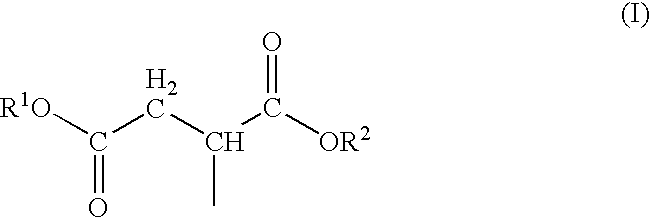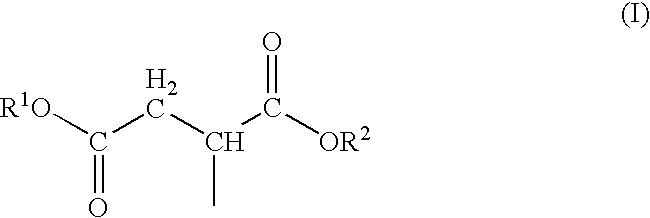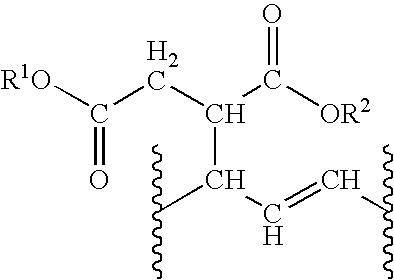Bio-based polyol
- Summary
- Abstract
- Description
- Claims
- Application Information
AI Technical Summary
Problems solved by technology
Method used
Image
Examples
example 1
Preparation of Bio-Based Polyester Resin (Polyol) (Comparative)
[0023]
ItemMonomer / IntermediateCharge (g)1Soybean Oil1000.902Maleic Anhydride222.273Ethylene Glycol304.774Glycerol0.345Butyltin tris(2-Ethyl hexanoate)1.23
1. Charge Items 1 and 2 to reactor at ambient temperature (ca. 25 C).
2. Heat resin to 200 C under Nitrogen with stirring.
3. Maintain resin at 200 C for 2 Hours, Monitor viscosity at 1 Hr intervals.
4. Cool resin to about 5 C.
5. Add Items 3, 4, and 5 to resin over 10 min interval; Maintain at 50 C for 30 mins.
6. Heat resin to 100 C and maintain at 100 C for 30 mins.
7. Heat resin to 225 C and hold at 225 C until AV≦5 (monitor AV and viscosity at 1 hr intervals).
8. When AV≦5 cool resin to ca. 150 C then filter and package.
[0024]The final resin had the following properties: Acid Value (AV) 2.58, Hydroxyl Number (OHN) 202.4, Mn 1900, Mw 66850, Viscosity at 25° C. 14425 cps (mPa·s).
example 2
Preparation of Bio-Based Polyester Resin (Comparative)
[0025]
ItemMonomer / IntermediateCharge (g)1Soybean Oil1004.852Maleic Anhydride222.923Ethylene Glycol284.104Glycerol0.385Butyltin tris(2-Ethyl hexanoate)0.58
1 Charge Items 1-2 to vessel at Ambient Temperature (25-30 C)
2 Heat resin to 200 C under Nitrogen with stirring
3 Maintain resin at 200 C for 2 Hours, Monitor viscosity every 1 Hr
4 Cool Resin to about 50 C
5 Add Item 5 to reactor
6 Add Item 3 and 4 to resin over 10 min interval; Maintain at 50 C for 30 mins
7 Heat slowly to 100 and maintain for 30 mins.
8 Heat resin to 210 C and hold at 210 C for 1 Hr, monitor AV and viscosity every 1 Hr
9 Maintain resin at 210 C until AV<20
10 Cool Resin to about 150 C; Filter and Package
[0026]The final resin had the following properties: Acid Value (AV) 16.4, Hydroxyl Number (OHN) 184.8, Mn 1800, Mw 36300, and Viscosity at 25° C. 8412 cps.
example 3
Preparation of Bio-Based Polyester Resin (Comparative)
[0027]
ItemMonomer / IntermediateCharge (g)1Soybean Oil1006.802Maleic Anhydride223.203Ethylene Glycol283.584Glycerol0.365Butyltin tris(2-Ethyl hexanoate)0.51
1 Charge Items 1-2 to vessel at Ambient Temperature (25-30 C)
2 Heat resin to 200 C under Nitrogen with stirring
3 Maintain resin at 200 C for 2 Hours, Monitor viscosity every 1 Hr
4 Cool Resin to about 6 C
5 Add Item 5 to reactor
6 Add Item 3 and 4 to resin over 10 min interval; Maintain at 50-60 C for 30 mins
7 Heat slowly to 100 and maintain for 30 mins.
8 Heat resin to 210 C and hold at 210 C for 0.5 Hr, Monitor AV and viscosity
9 When AV<25.0 Apply vacuum (ea. 300) and hold resin at 210 C for 0.5 Hr;
10 Sample resin for AV and Viscosity; When AV<12.0 Start Cooling
11 Cool Resin to about 150 C; Filter and Package
[0028]The final resin had the following properties: Acid Value (AV) 11.4, Hydroxyl Number (OHN) 172.7, Mn 2050, Mw 182100, and Viscosity at 25° C. 24000 cps.
PUM
| Property | Measurement | Unit |
|---|---|---|
| Temperature | aaaaa | aaaaa |
| Temperature | aaaaa | aaaaa |
| Temperature | aaaaa | aaaaa |
Abstract
Description
Claims
Application Information
 Login to View More
Login to View More - R&D
- Intellectual Property
- Life Sciences
- Materials
- Tech Scout
- Unparalleled Data Quality
- Higher Quality Content
- 60% Fewer Hallucinations
Browse by: Latest US Patents, China's latest patents, Technical Efficacy Thesaurus, Application Domain, Technology Topic, Popular Technical Reports.
© 2025 PatSnap. All rights reserved.Legal|Privacy policy|Modern Slavery Act Transparency Statement|Sitemap|About US| Contact US: help@patsnap.com



